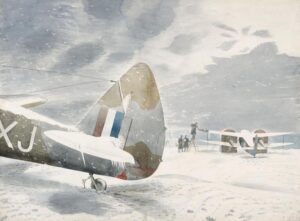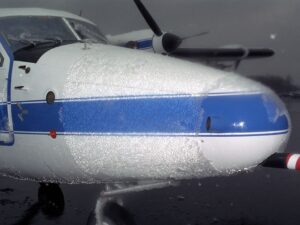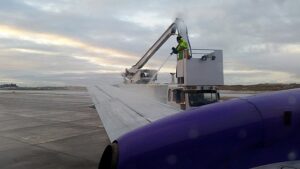
De-icing is a specialized procedure used in aviation to remove or prevent the formation of ice and snow on aircraft surfaces. It’s a task that must be performed before every flight during winter months when icing, snow, or slush is visible on aircraft surfaces or when the risk of buildup is high. The process typically involves applying de-icing fluids or chemicals to melt existing ice or create a protective layer that prevents further ice accumulation. Ice buildup on aircraft wings can affect aerodynamic properties and performance and pose safety risks. By ensuring clean and ice-free surfaces, de-icing not only contributes to safe aircraft operation but also plays a crucial role in preventing delays due to wintry conditions.
De-icing fluids work by melting existing ice and preventing further accumulation on aircraft surfaces. They are heated and sprayed under pressure, creating a protective layer that keeps wings, tail, and other critical areas ice-free during wintry conditions.
A brief view of the types of De-icing fluids
These specialized fluids come in various types, primarily composed of either ethylene glycol (EG) or propylene glycol (PG). Here’s a breakdown of the different types:
- Type I fluids: These have low viscosity and are used for immediate de-icing. They’re sprayed hot (around 130–180 °F) to remove snow, ice, and frost. They’re typically dyed orange for easy identification.
- Type II fluids: These are pseudoplastic and thicker fluids that prevent contamination from adhering to aircraft surfaces. They are useful for larger planes, but their viscosity breaks down at high speeds. They are clear in color.
- Type III fluids: They are a compromise between Types I and II, designed for slower aircraft. They are bright yellow.
- Type IV fluids: They are similar to Type II but with a longer holdover time. Dyed green for consistent application. These fluids are known as ani-icing fluids, preventing re-icing after initial de-icing with Type I.
The science behind De-icing fluids.
When temperatures drop, and rain or snow falls, aircraft skin becomes cooler than the surrounding temperature, which causes rainwater or snow to freeze into clear ice on the plane’s surface, similar to what you see on cars parked outside after heavy sleet or snowfall. Despite appearances, airplanes are designed to travel at high speeds. Even if the weather doesn’t seem cold, the air gets significantly colder when an aircraft speeds up due to the wind chill effect.


De-icing process:
- The first step involves spraying the aircraft with a heated solution made of glycol (derived from ethylene, used in polyester and antifreeze) and water. This high-pressure fluid melts existing contaminants like snow and ice.
- A different type of fluid is used for anti-icing (preventing further buildup). However, the orange-colored propylene glycol fluid effectively removes snow, ice, or slush from the aircraft surface during de-icing.
The viscosity (thickness) of de-icing fluids varies based on their type (I, II, III, or IV). Thinner fluids (Type I) are used for initial de-icing, while thicker ones (Type IV) provide longer protection. The fluid’s viscosity affects its flow characteristics during application. High-pressure nozzles spray the fluid onto the aircraft, ensuring even coverage.
Anti-Icing Properties:
- After de-icing, anti-icing fluids may be applied to prevent further ice buildup during flight.
- These fluids create a protective layer that resists ice formation. They have longer-lasting effects than de-icing fluids.
Composition of De-Icing Fluids:
De-icing fluids are typically composed of a mixture of water and glycol-based compounds. The most common glycols used are ethylene glycol (similar to what’s found in antifreeze) and propylene glycol. These glycols lower the freezing point of the fluid, allowing it to remain in liquid form even at sub-zero temperatures. Additives such as surfactants and thickening agents are also included to enhance performance and adherence to the aircraft surface.
What impacts do Deicing fluids have on the environment?
De-icing fluids typically contain either Ethylene Glycol (EG) or Propylene Glycol (PG). EG is toxic, while PG is non-toxic. The choice of fluid depends on the specific application and regulations.
In water, EG is not persistent and biodegrades aerobically and anaerobically. PG also behaves similarly. It is not readily volatile and has an atmospheric half-life of approximately one day, and biodegrades anaerobically in about one day. Both EG and PG are disposed of and treated at standard wastewater plants. Some airports are adopting more environmentally friendly options, such as using 1,3-propanediol (a by-product of corn fermentation).
When de-icing fluids are applied to aircraft, they can run off onto the ground and eventually seep into the soil. Ethylene Glycol (EG) and Propylene Glycol (PG) are both water-soluble. While PG is less toxic, EG can be harmful to aquatic life. The runoff can increase the salinity of groundwater, affecting local ecosystems.
Drawbacks:
- Toxicity: Many de-icing fluids, including glycol-based ones, are toxic to humans and other mammals. They can harm ecosystems around airports.
- Groundwater Salinity: Discharging de-icing fluids into soil can increase groundwater salinity.
- Aquatic Habitats: Nearby aquatic habitats may be affected, harming fish and wildlife.
Solutions to mitigate the negative environmental impact of de-icing fluids.
As deicing fluids has certain drawbacks, such as harming nature, some measures must be implemented to conserve the environment. To maximize the benefits, airports try to minimize environmental impact through recovery efforts.


Recovery Efforts:
- Many airports aim to “go green” by recovering used de-icing fluid.
- Larger aircraft can use over 1000 gallons of diluted de-icing solution, much of which runs off onto the ground.
- The EPA mandates that new airports in cold climates recover at least 60% of de-icing fluid.
- Airports collect used de-icing fluid for treatment.
- Standard wastewater treatment plants handle these fluids, ensuring proper disposal.
Some measures indicate successful fluid recovery.
Here are some strategies airports can employ to mitigate the environmental impact of deicing fluids:
- Fluid Recovery Systems: Implementing fluid recovery systems allows airports to collect and treat used deicing fluids. These systems separate glycol-based fluids from snow and ice, enabling their reuse or safe disposal. These systems use vacuum trucks to collect deicing fluids from runways, taxiways, and aprons. The collected fluids are then treated or recycled.
- Biodegradable Formulations: Encouraging biodegradable deicing fluids helps minimize harm to ecosystems. Some newer formulations use organic compounds that conk out more readily in the environment. They introduce specific microorganisms that break down glycol-based fluids into harmless byproducts. This process occurs in designated treatment areas.
- Storage and Containment: Properly storing and containing deicing fluids prevents leaks and runoff into nearby water bodies. Lined containment areas can capture any spills or excess fluids. Airports install pits or sumps near deicing areas where used fluids accumulate. These pits are connected to a central collection system that pumps the fluids to treatment facilities.
- Vegetated Buffer Zones: Creating vegetated buffer zones around deicing areas helps filter and absorb runoff. Native plants can reduce the impact of glycol on soil and water quality.
- Monitoring and Reporting: Regular monitoring of glycol levels in soil, groundwater, and surface water ensures timely detection of contamination. Airports can then take corrective actions as needed.
- Recycling and Reuse: Airports can recycle recovered deicing fluids by filtering and reusing them for subsequent deicing operations, reducing the need for fresh fluid.


The effectiveness of these systems depends on factors like climate, airport size, and available infrastructure.
Types Of Deicing Equipment with their benefits and drawbacks.
Here are some common types of deicing equipment used in aviation, along with their advantages and disadvantages:
| Equipment | Advantages | Disadvantages |
| Pneumatic De-ice Boots | These boots use compressor bleed air, ensuring continuous de-icing protection. They can cycle different sections of the boots for ice removal. | Inflating the boot changes the airfoil’s aerodynamics, increasing stalling speed. Ice can form behind the boot, reducing effectiveness. |
| Bleed Air Heated Surfaces | Efficient use of bleed air from the turbine section prevents ice formation while the engine runs. | Late activation risks runback (freezing aft of protected surfaces). Ice chunks may beak off the engine cowl. |
| Electrically Heated Surfaces | Jet windshields and other electrically heated surfaces always have anti-ice and de-ice protection (unless there’s an electrical failure). | Risk of damage during ground operations. It cannot heat large areas like wings and tail surfaces. |
| Weeping Wings | Weeping wings protect the entire airfoil surface. TKS fluid runs across the top and bottom, forming a protective layer against ice. | TKS fluid is finite, so planning is crucial. Most TKS-equipped aircraft have 1.5-2.5 hours of protection. |
| Electro-Mechanical Expulsion Deicing (EMEDS) | EMEDS detects ice via sensors and vibrates coils behind the leading edge skin to break off ice. No modification to airfoil surface. | It is not applicable to large commercial aircraft since the equipment must be built into the airframe and only applies to some surfaces. |
